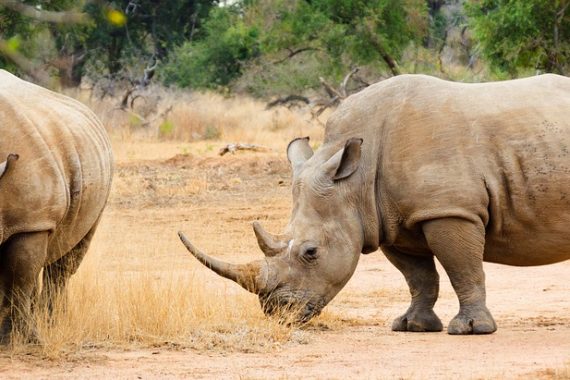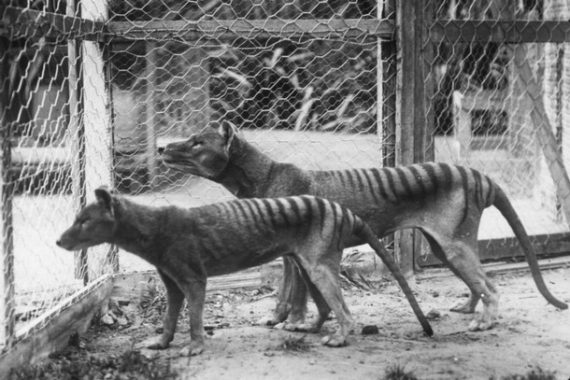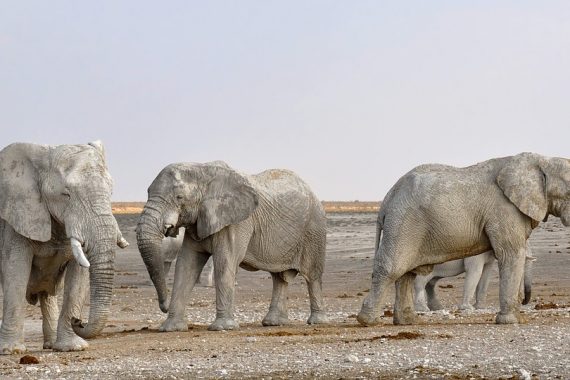Binturong (Arctictis binturong)
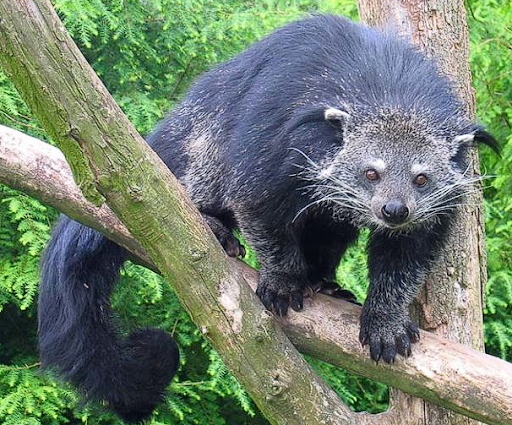
Image from https://news.mongabay.com/2016/10/its-a-bear-its-a-cat-no-its-a-binturong-and-its-threatened/
Is it a small bear? Is it a cat? Is it a lemur? Well actually, the Binturong, or bear cat, is in a genus all by itself. This is fitting for such an unusual animal, that purrs and grooms like a cat, has a prehensile tail like a monkey and produces an odour from its scent glands that smells like buttered popcorn.
They are medium sized mammals, covered in bristly black hair, with a bushy tail and a stout build. They have long whiskers and bright white fur sprouts out of their ears. The Binturong can be found throughout South and South-Eastern Asia but is most often sighted in Northeast India, Bangladesh and on the Philippine Islands of Palawan and Calauit. They are mostly arboreal, spending their time amongst the treetops of dense forest, although camera trapping studies have identified that they come down to the forest floor more than researchers previously thought. This makes sense, as they are far heavier and more ponderous than many arboreal species, and so they need to descend to the forest floor to climb the next tree, rather than leaping from one to the other like a lemur might. Camera trapping also showed they are far more active in the day than initially thought; they were once believed to be almost entirely nocturnal.
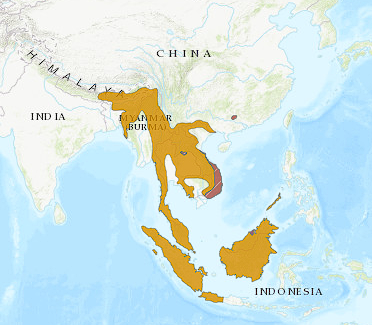
The geographic range of the Binturong (image from https://www.iucnredlist.org/species/41690/45217088)
The species is omnivorous eating anything from insects, eggs, shoots, seeds, fish and pretty much anything they can catch. This omnivorous diet makes them important seed dispersers and a vital part of the tropical forest ecosystem.
Although the species is in a genus all of its own, Arctictis, there are several subspecies of the Binturong recognised currently, mainly:
- Arctictis binturong albifrons: found from Nepal to the northern Indochinese region
- Arctictis binturong binturong: in the Malay-Thai peninsula and into Sumatra
- Arctictis binturong penicillatus: on the islands of Java and Borneo
- Arctictis binturong whitei: on Palawan Island in the Philippines. This subspecies is of particular conservation interest as it has such a small distribution which is massively threatened by deforestation. 11% of forest cover has been lost in Palawan since 2000, and the island is a hotbed of illegal wildlife trade, which Binturongs are often trapped and killed for.
Generally, the ecology of this unusual little creature is poorly understood. Unlike large carnivores, which are often classed as flagship species, bringing a lot of attention and money, small carnivores like the Binturong don’t attract much conservation or research effort. There isn’t much money out there for interested researchers to spend studying and conserving the Binturong, especially concerning considering they are now listed as Vulnerable by the IUCN red list, and their populations are in decline thanks to the intensive logging and destruction of Asian forests.
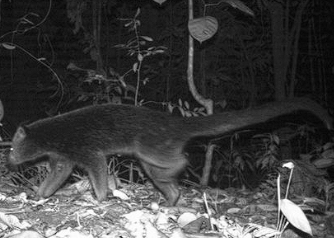
The elusive Binturong captured on a camera trap in Meru Betiri National Park, Java, Indonesia (Image from Avriandy et al, 2020)
A different kind of cologne: buttered popcorn?
Arguably Binturongs are most famous for smelling like hot buttered popcorn to the human nose. This distinctive scent is likely to be down to the volatile compound 2-acetyl-1-pyrroline (2-AP). Both male and female Binturongs possess a perineal scent gland which they use to scent mark tree trunks, although the males scent mark more frequently, as is the case with many species. They also scent mark using urine, often splashing it across their feet so they can spread their scent as they mooch about the forest.
A shrinking home: the threats facing Binturongs
Deforestation is one of the biggest threats facing the bear cats and is likely the main reason for the increasingly rare sightings. Southeast Asia is home to around 15% of the earth’s tropical forests, and yet between 2000 and 2019 a forest area the size of Thailand has been lost to agriculture. In China, where deforestation has been particularly rampant, suitable habitats for the Binturong have been eliminated almost entirely in parts. What limited research has been done has found no evidence that Binturongs will use these agricultural areas in place of their undisturbed forest habitat. Binturongs almost exclusively inhabit lowland forests, which have been massively cleared to make way for palm oil plantations. Currently, Indonesia and Malaysia produce 80% of the worlds palm oil crop and so are disproportionately suffering from some of the highest rates of forest clearance in the world. The IUCN has also discovered the disturbing truth that even legally protected reserves do not escape deforestation; between 2000 and 2012, 40% of the forest lost was in areas where logging is restricted by law.
Palm oil is an incredibly versatile oil that is widely used the world over. To add to this, the oil palm is an incredibly efficient crop, allowing massive quantities of oil to be generated from a relatively small area. Unfortunately, the intense demand for this crop causes vast swathes of tropical rainforest to be cleared to grow this incredibly profitable crop.
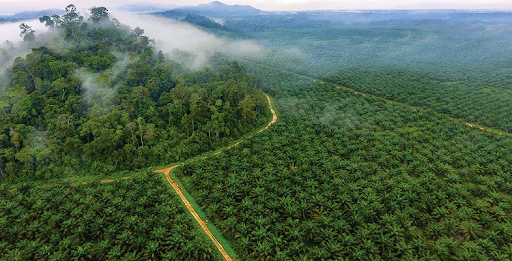
An example of a palm oil plantation in Indonesia (image from https://www.science.org/content/article/courting-controversy-scientists-team-industry-tackle-one-world-s-most-destructive-crops)
Aside from this habitat loss, Binturongs are hunted for their meat. In the Philippines, the species is removed from the wild for the illegal pet trade; in the wildlife markets in Laos, the Binturong is reported as being one of the commonest caged animals by TRAFFIC, the leading anti-wildlife trade charity. Although they may be cute and cat like, Binturongs are fierce wild animals and do not make good pets. As camera trapping studies revealed that Binturongs descend to the forest floor more often than initially thought, the risk of snares to this species is now a bigger concern. Snares are commonly used across its range to catch a range of mammals, and so it is reasonable to assume, despite a lack of data, that Binturongs are being trapped in snares. In Vietnam, China and Laos, the twin pressures of intense logging and trapping are driving the Binturong towards local extinctions.
In Indonesia, coffee farmers trap civet cats and feed the animals coffee beans to produce the expensive local delicacy ‘kopi luwak’ or ‘civet coffee’, which is created from the coffee beans the animals poop out. Binturongs are now reported being removed from the wild to be raised on these farms.
Conservation Optimism
Despite the lack of work on Binturongs, there is still good news out there. Bear cats are popular zoo animals thanks to their cute appearance and popcorn smell, and this provides an insurance population, and a source of breeding and healthy genetics for the future. You can see Binturongs for yourself in many zoos, including Chester Zoo and Edinburgh Zoo in the UK, San Diego Zoo and Los Angeles Zoo and Botanical Gardens in the US.
Binturongs are listed on Appendix 3 of CITES, making all trade in live Binturong or Binturong body parts illegal. It is also listed under India’s Schedule 1 of the Wildlife Protection Act, and under Schedule 2 of Sabah’s Wildlife Conservation Enactment 1997 in Borneo.
The Binturong is known to exist inside protected areas, but levels of protection vary from place to place, and without radio collar and further camera trapping studies to better map distribution of the species, conservationists cannot target protection in the right areas.
As mentioned above, Binturongs just don’t attract the money and attention that other species do. However, one French charity, ABConservation, has chosen to take on the Binturong as their conservation mission. You can check out their mission here:
https://www.abconservation.org/fr/
If you want to help tackle the wildlife trade, you can look into the work of TRAFFIC, a charity dedicated to ensuring legal, safe and sustainable trade in animals and plants.
Check out their website here: https://www.traffic.org/
They are involved in a range of projects and initiatives to change attitudes towards wildlife products and providing sustainable alternatives for people earning a living from the wildlife trade.
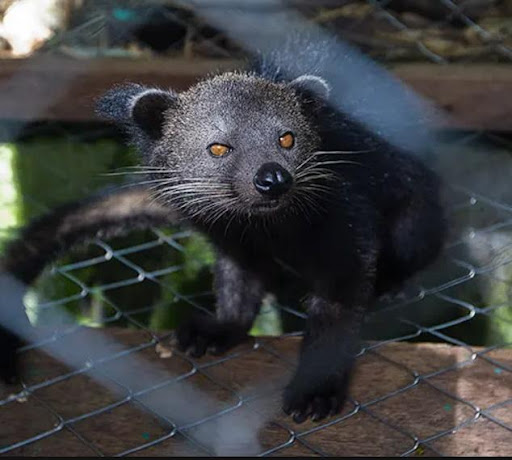
A captive Bear cat in a wildlife market in Aceh, Sumatra. Sadly, these dreadful markets are where Biodiversity goes to die. (image from Paul Hilton https://www.theguardian.com/environment/gallery/2013/jun/20/endangered-wildlife-market-indonesia-in-pictures)
To learn more about the threats facing Asian biodiversity and how to help visit Wildlife Asia’s website at : https://wildlifeasia.org.au/
This is an NGO working alongside other charities and local communities to promote more sustainable futures for wildlife and people. They are particularly involved in tackling the Asian songbird trade, protecting the Javan Gibbon and conserving the vital Leuser ecosystem.
Awesome videos
References
Borgeois, A. Kayser, P. Debruille, A. and Veron, G. (2020) ‘Binturong conservation: the relationship between the zoo community and ABConservation for an integrated conservation programme in Palawan, Philippines.’ International Zoo Yearbook, 54(1)
Giordano, A.J. (2019) ‘Predicted distribution of the binturong on Borneo.’ Raffles Bulletin of Zoology.
Greene, L.K. Wallen, T.W. Moresco, A. Goodwin, T.E. and Drea, C.M. (2016) ‘Reproductive endocrine patterns and volatile urinary compounds of Arctictis binturong: discovering why bear cats smell like popcorn.’ The Science of Nature.
https://www.iucnredlist.org/species/41690/45217088
https://www.nationalgeographic.com/animals/article/160429-kopi-luwak-captive-civet-coffee-Indonesia
https://news.mongabay.com/2016/10/its-a-bear-its-a-cat-no-its-a-binturong-and-its-threatened/
Veron, G. Debruille, A. Kayser, P. Fernandez, D.A.P. and Borgeois, A. (2019) ‘Genetic diversity and structure of the binturong Arctictis binturong – status of the elusive Palawan binturong and implications for conservation.’ Zoological Journal, 188(1)


